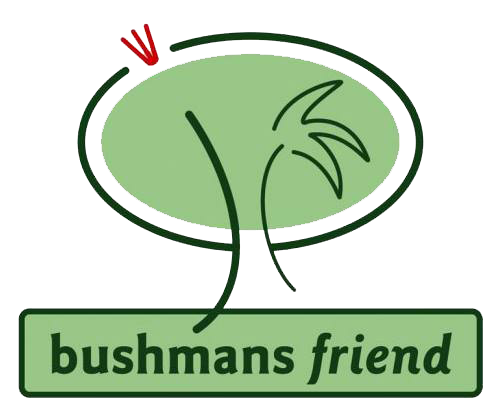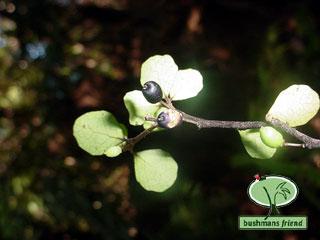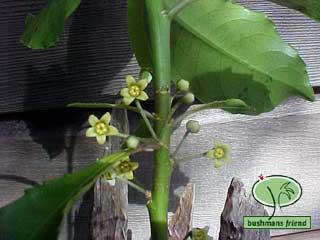
| Purchase recommended products The classic New Zealand identification guide. Every home should have one. Buy it here.
The Reed Field Guide to New Zealand Native Trees J.T. Salmon Which Native Plant Can I Grow Here? Andrew Crowe 100 Best NZ Native Plants for Gardens Pohutukawa Diana Adams Art Print
|  |
A member of the violet family. A shrub or small tree to 10m. White splotches on the bark. Ovate-oblong leaves 5-14cm long. A violet-blue berry 4-6mm diameter
A common shrub or small tree.
Melicytus are dioecious with separate male and female plants. Female plants need to be sourced to gather seed.
Mahoe is insect pollinated with midges, gnats, hover flies, butterflies, bees and ants all seen visiting the flowers and presumably being involved with pollination. The fruits are fleshy berries that turn purple when ripe. The Pigeon, Tui, Whitehead, South Island Robin and silver eye have been observed eating the berries.
Two interesting features of the New Zealand flora are that many plants have small, inconspicuous, unspecialised flowers that lack bright colours and many plants are dioecious, with unisexual flowers. Mahoe exhibits both these characteristics.

The species name ramiflorus refers to flowers being borne on the brittle branches
Melicytus ramiflorus flowers in a series of distinct flushes from November through to March. These flowering episodes occur on the same branch. The intensity of flowering varies from year to year and between episodes. These flowering episodes seem to extend the time for which berries are ripe and increase reproductive fitness. In a varying environment, spreading an activity out over an extended period of time may be a risk averting strategy. The flowers are a prized food of the opposum.
Ripe berries are present from mid summer to autumn.The episodic nature of flowering means a large number of berries are available over a long length of time. The berries are clustered together on the branches and are readily accessible to foraging birds and animals.
The seeds of Mahoe possess a chemical germination inhibitor. The seeds will not germinate until this brown coloured exudate is removed. Once the exudate is leached away and is replaced by fresh water, the germination of Mahoe is rapid. This inhibitor may function in two ways; as an inhibitor of Mahoe germination and as an inhibitor of other species which grow with and could compete with Mahoe.
The white sploches on Mahoe bark and serrated margin of leaves
Berries which hold up to 10 seed
Maui fetched fire from the mahoe tree on Three kings Islands and brought it to the mainland, having first fished up the giant stingray that was the North island of New Zealand and muriwhenua the tail.
The tribes of Muriwhenua: their origins & stories Dorothy Urlich Cloher Auckland university
Mahoe was one of the woods maori would utilise to create fire.
Fire
The Maori made his fire by friction, and used te hika ahi, the fire plough, to get his fire.two pieces of wood which had been thoroughly dried were used. One , the kauahi, or lower stick, a piece of Mahoe (Melicytus ramiflorus), was generally 14 to 18 inches long, 2 or 3 inches wide, and 1 to 2 inches thick. This was very soft wood, and the stick could be used on both sides. Pate (Schifflera digitata) was sometimes used as a kauahi, but Mahoe was much preferred.the other piece of wood used was te hika, the rubbing stick, made from Kaikomako, (Pennantia corymbosa), a very hard compact and durable wood. The stick was scraped down with tuhua (obsidian) or shell, to a rounded point or end.
Te Hika also means “generating stick”, and a man and woman would both take part in generating fire, as both took part in the generation of children. The kauahi or lower stick was kept in position by the woman, while the man worked on the hika, or the generating stick. A small log is placed on the ground, with the lower stick against it. The lower end of the kauahi is held firmly in position by the woman, who stands with her feet on it, and the man kneels at the other end, which is raised up 5 or 6 inches from the ground. He holds te hika firmly, with his thumbs underneath, and his fingers placed flat on the outer part, with his right hand passing over his left. He begins rubbing the lower stick until a groove is formed about 5 inches long. The rubbing is slow at first , then a little quicker, with heavier pressure, until a hollow, a1/4 to1/2 inch deep, is formed, and a minute heap of dust begins to collect at the lower end of the groove. When plenty of dust has been made, the man uses te hika again, working it back and forwards more vigorously and with greater pressure, and the hollow gets hotter. He knows by the smell when the fire will come. The hollow gets darker, and from the heap of dust comes a little smoke, then a little bright spec in the middle.” A kua ka tea hi” the fire has come to life.
Makareti Maggie Papakura: The old time Maori 1938
\
The timber of Mahoe.
Unlike the other Melicytus with it's small leaves and divaricating habit.

Leaves 7-16cm long and thick
er and glossier. Local in its distribution, common in the North. Violet blue-black berries sparsely on the stems.

|
|
I recommend the following books on New Zealand native plants
100 Best NZ Native Plants for Gardens
The Reed Field Guide to New Zealand Native Trees
Trees and Shrubs of New Zealand
Gardener's Encyclopaedia of NZ Native Plants
A Photographic Guide to Ferns of New Zealand
New Zealand Trees and Shrubs: A Comprehensive Guide to Cultivation and Identification
From Weta to Kauri: A Guide to the NZ Forest
Which Native Forest Plant? (Which S.)
Articles